 Image search results - "folk" Image search results - "folk" |

Sugawara house from Tsuruoka city, Yamagata Prefecture. In heavy snow, the front window was used as the door.
|
|

Ceiling
|
|

Kitamura house brought from Hadano, Kanagawa
|
|

Kitamura house
|
|

Nihon Minkaen is an outdoor museum of traditional farm and merchant houses with thatched roofs. They have 25 homes from around Japan many were donated to the museum for preservation.
|
|
|
|

Thatched roof
|
|

Water nozzles aimed at the house. No smoking.
|
|
|
|
|

Yamada house
|
|
|
|

Emukai house brought from Nanto, Toyama. In the gasshi-zukuri style with steep roof. Kawasaki Nihon Minkaen
|
|

Nihon Minkaen, Kawasaki, Kanagawa
|
|

Inside Emukai house
|
|
|
|
|
|
|
|

Nihon Minkaen, Kawasaki, Kanagawa
|
|

Toilet
|
|

The museum park has 25 homes from around Japan many were donated to the museum for preservation. Near Mukogaoka-yuen Station on the Odakyu Line. Closed Mon. Admission 500 yen.
|
|

Water mill
|
|

Inside water mill
|
|

Hydrangea
|
|

Yasugi is a rural city most famous for the Yasugi-bushi folk song and dance. It has JR Yasugi Station.
|
|

JR Yasugi Station welcomes visitors to the land of Yasugi-bushi.
|
|

JR Yasugi Station welcomes visitors to the land of Yasugi-bushi.
|
|

JR Yasugi Station welcomes visitors to the land of Yasugi-bushi.
|
|

Yasugi-bushi Engeikan Hall is a Japanese-style theater where they perform Yasugi-bushi, a local folk song and dance.
|
|

The hall includes a gift shop and restaurant. Yasugi-bushi Engeikan is next to Adachi Museum of Art. Easy to see both places.
|
|

Giant loach in front of the hall in Yasugi, Shimane.
|
|
|
|

Inside the Yasugi-bushi Engeikan Hall is a Japanese-style theater. They perform four times per day. Admission is ¥600 for adults, ¥300 for kids.
|
|

Hanamichi in the theater.
|
|

Comfortable chairs.
|
|
|
|
|
|
|
|
|
|
|

Playing the tsuzumi shoulder drum.
|
|

The most famous Yasugi-bushi song is "Dojo-sukui" (Loach Scooping) danced by a Hyottoko comical man. The dancer uses a basket scoop to catch the loaches.
|
|
|
|
|
|
|

"Dojo-sukui" (Loach Scooping) also danced by women.
|
|
|
|
|
|
|
|
|

Afterward, they invited members of the audience on stage to try the loach scooping dance.
|
|

Names of the performers from the Yasugi-bushi Preservation Society.
|
|

Display hall for Yasugi-bushi.
|
|

About Yasugi-bushi.
|
|

Tsuzumi shoulder drums used in Yasugi-bushi.
|
|

Gift shop sells dojo loach confections.
|
|

Next to the theater is this restaurant.
|
|

Nice lunch.
|
|

Sign for Oichi-no-Sato, a complex consisting of a public library and folk history museums. Named after Ichi, the wife of Lord Azai Nagamasa who resided at Odani Castle. She was also the younger sister of warlord Oda Nobunaga.
|
|

Oichi or Ichi (1547–1583) gave birth to three daughters who associated with famous men. They were Chacha (Toyotomi Hideyoshi's concubine), Hatsu (married Kyogoku Takatsugu), and Ogo (married Tokugawa Hidetada).
|
|

Map of Oichi-no-Sato. The biggest building on the left is the Azai Public Library. If you don't have a car, catch the Kokoku Bus (Takayama Route) at Nagahama Station and get off at Plaza Fukura no Mori-mae (プラザふくらの森前). Walk 10 min.
|
|

Oichi-no-Sato includes Azai Public Library on the left. Its entrance looks like a castle gate. Address: Oyoricho 528, Nagahama. 大依町 Phone: 0749-74-0101 浅井図書館
|
|
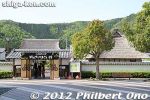
Within Oichi-no-Sato is the Azai Folk History Museum, a small complex of history museums.
|
|
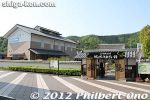
Walk past the library and you come to the gate of the Azai Folk History Museum. Admission 300 yen. Open 9 am to 5 pm, closed Mon. (open if a national holiday) and the day after a national holiday.
|
|
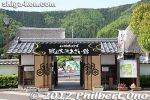
Entrance to Azai Folk History Museum.
|
|

Azai Folk History Museum has a few buildings around an iris pond.
|
|

About the Battle of Anegawa.
|
|
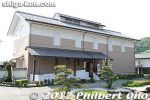
On the left is this modern structure called the Folk Studies Museum or Kyodo Gakushu-kan. It centers on the history of Odani Castle and three generations of the Azai Clan. 郷土学習館
|
|
|
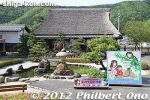
In the rear is the thatch-roofed Shichirinkan 七りん館
|
|

The Azai Folk History Museum (Azai Rekishi Minzoku Shiryokan) has two large thatched-roof houses. This one is called Itohime no Yakata which shows Azai's silk production history. 糸姫の館 MAP
|
|
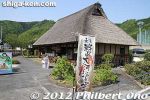
Itohime no Yakata
|
|
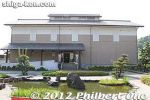
Folk Studies Museum or Kyodo Gakushu-kan. It centers on the history of Odani Castle and three generations of the Azai Clan. 郷土学習館
|
|
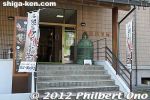
Entrance to Folk Studies Museum.
|
|
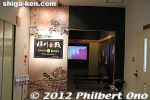
Video room explaining the Battle of Anegawa River.
|
|
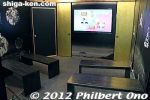
Video screening room explaining the Battle of Anegawa River.
|
|
|
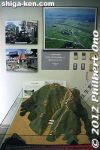
Model of Odani Castle on Mt. Odani.
|
|
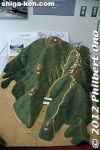
Model of Odani Castle.
|
|
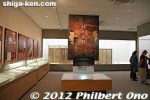
Exhibits about the Battle of Anegawa River.
|
|
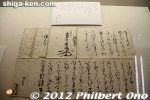
Order written by Toyotomi Hideyoshi to award any Shizugatake residents a reward for killing his enemy.
|
|
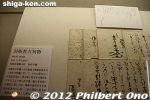
Letter from Ishida Mitsunari.
|
|
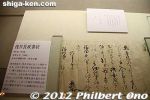
Thank you letter from Azai Nagamasa to a temple for their cooperation in civil construction work.
|
|
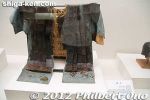
Armor worn around the belly by low-ranking samurai to protect against spears and swords. Supposedly used in the Battle of Anegawa.
|
|
|
|
|
|
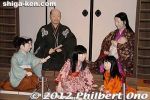
Azai Nagamasa, wife Oichi, son Manpukumaru (left), Chacha in the middle, Hatsu on the right, and Go in Oichi's arms.
|
|
|
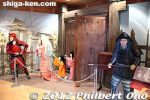
Depiction of Oichi and her daughters being allowed to escape Odani Castle while it was under attack by Oda Nobunaga in 1573.
|
|
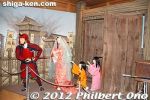
Depiction of Oichi and her three daughters being allowed to escape Odani Castle while it was under attack by Oda Nobunaga in 1573.
|
|
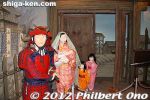
Oichi and daughter Chacha, Hatsu, and Go were led to safety by Fujikake Nagakatsu, a retainer of Oda Nobunaga. He took them to Gifu Castle.
|
|
|
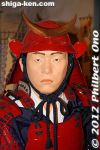
A few years before the attack, Fujikake Nagakatsu, a retainer of Oda Nobunaga, had been assigned to Odani Castle to look after Nobunaga's sister Oichi. 藤懸永勝
|
|
|
|

About the castle gate.
|
|
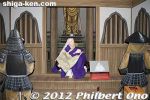
Right after their escape from Odani Castle, Oichi and her three daughters went to a nearby temple in Nagahama whose priest was Nagamasa's older sister. The priest hid the three girls in her robes when Nobunaga's men arrived.It is not known for sure where Oichi and the Azai sisters escaped to. This is only one supposition.
|
|
|
|
|
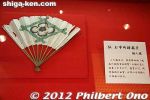
Folding fan supposedly used by Oichi.
|
|
|

This folding panel greets you with a portrait of Lord Azai Nagamasa and wife Ichi.
|
|

Model of Odani Castle on a mountaintop.
|
|

More exhibits about local history.
|
|

Portrait panels of Nagamasa, Ichi, and their three daughters.
|
|

Ichi or Oichi, wife of Azai Nagamasa.
|
|

Lord Azai Nagamasa
|
|

Map of the Battle of Anegawa where Lord Azai Nagamasa fought against Tokugawa Ieyasu and Oda Nobunaga in 1570.
|
|

Second floor of the museum with a fake stone castle gate.
|
|
|

Relics from Odani Castle
|
|

Fan said to have belonged to Ichi.
|
|

Blacksmith-related materials.
|
|

Photo of an unusual ax.
|
|

Inside Shichirinkan, a former blacksmith's house from the 19th century. 七りん館
|
|

When I visited in Feb. 2009, there was an exhibit showing artifacts of a local Okonai Festival (held in various locations during Jan. to March to pray for a good harvest).
|
|

Feast for Okonai Festival.
|
|

Food for Okonai Festival.
|
|
|
|
|
|

Kitchen.
|
|
|
|
|

Wooden bathtub
|
|

How they bathed in the bathtub.
|
|

Near the entrance was the wooden bath.
|
|
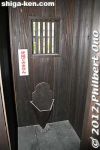
Urinal
|
|
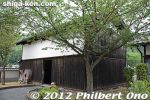
Blacksmith's shop
|
|
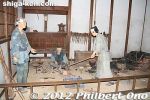
Inside Blacksmith's shop.
|
|
|
|
|
|
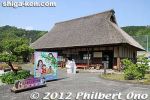
This is Itohime no Yakata which shows Azai's silk production history. 糸姫の館
|
|
|
|
|
|
|
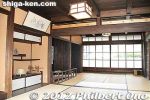
Inside Itohime no Yakata.
|
|

Large exhibition rooms.
|
|

Products which use silk threads made in Azai. They were mainly used for the strings of string instruments such as the koto, samisen, and biwa lute.
|
|

Koto strings made of Azai silk threads. Numerous silk threads are twisted together to make a koto string.
|
|

Biwa strings
|
|

Biwa lute
|
|

Silk cocoons.
|
|

Room with a hearth.
|
|
|
|
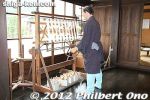
Silk threads.
|
|
|
|
|
|
|
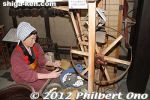
Weaver
|
|
|

Model of silkworm racks.
|
|
|

A mannequin spinning silk thread.
|
|
|
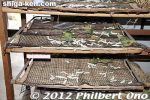
Model of silkworm racks.
|
|
|
|
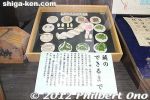
Silk thread
|
|
|
|
|
|
|
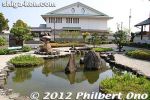
Iris pond
|
|
|

The 37th Otsuka Awa Odori was held on Aug. 26, 2009 (Wed.) in the middle of the week from about 5 pm to 9 pm. They paraded on the main road in front of the south side of JR Otsuka Station on the Yamanote Line in Tokyo.
|
|

Both sides of the road were almost totally covered with vinyl mats by people reserving a spot to watch the dance. The festival seemed to be mainly for the local folks, not for tourists from outside who could not get close to the roadside.
|
|

So it was not a good situation for taking pictures. The dance route was short, maybe only 300 meters. They danced on only one road. That's why it was quite crowded.
|
|

Sugamokko-ren すがもっ子連
|
|
|

They are from Toshimagaoka Joshi Gakuen, a private girls' school. 豊島岡女子学園 桃李連
|
|

Otsuka Awa Odori, Tokyo
|
|
|
|
|
|
|

Otsuka Awa Odori paper lanterns
|
|

Seiwa-ren 盛和連
|
|
|
|
|
|

Seiwa-ren 盛和連
|
|
|
|
|
|

Sun Mall Otsuka Ekimae-ren. サンモール大塚駅前連
|
|
|
|
|

Sun Mall Otsuka Ekimae-ren. サンモール大塚駅前連
|
|

Sanwa-ren 三和蓮
|
|
|

Otsuka Awa Odori
|
|

Otsuka Awa Odori
|
|

Shoko-ren 商興連
|
|
|

Shoko-ren 商興連
|
|
|
|
|
|
|

Otsuka Awa Odori
|
|
|
|
|
|
|
|
|
|
|
|

Kumegawa-ren, from Higashi-Murayama (not Otsuka) 久米川連
|
|
|
|
|

Kumegawa-ren, from Higashi-Murayama (not Otsuka) 久米川連
|
|

Keyaki-ren from neighboring Itabashi Ward. 板橋区役所 けやき連
|
|

Keyaki-ren from neighboring Itabashi Ward. 板橋区役所 けやき連
|
|

Shinsui-ren 新粋連
|
|

Shinsui-ren 新粋連
|
|

Toshima Kuyakusho-ren (Ward Office) 豊島区役所連
|
|

They work at the Toshima Ward Office (City Hall).
|
|
|
|

Toshima Kuyakusho-ren (Ward Office) 豊島区役所連
|
|
|
|

Toshima Kuyakusho-ren (Ward Office), Otsuka Awa Odori 豊島区役所連
|
|
|

Tenkei-ren from Shinjuku. 天恵連
|
|
|

Sugamo-ren すがも連
|
|

Sugamo is a neighboring train station, also in Toshima Ward.
|
|
|

Otsuka Awa Odori poster for 2009. The dance is held on only one evening.
|
|
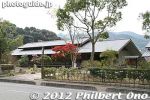
Kuka Folk History Museum is part of the learning village.
|
|

Kuka also has this history museum called the Kuka Folk History Museum (久賀歴史民俗資料館). Open 9 am to 4:30 pm (enter by 4 pm). Closed Mon. Admission 400 yen.
|
|
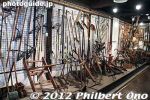
The museum has exhibits of local fishing and farming.
|
|
|
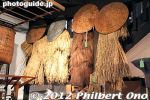
Snow coats.
|
|
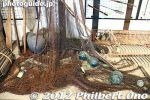
Fishing nets.
|
|
|
|
|
|